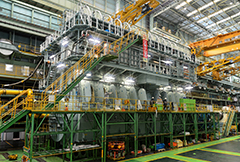Ships Engines History
Marine propulsion is the mechanism or system used to generate thrust to move a ship or boat across water. While paddles and sails are still used on some smaller boats, most modern ships are propelled by mechanical systems consisting of an electric motor or engine turning a propeller, or less frequently, in pump-jets, an impeller. Marine engineering is the discipline concerned with the engineering design process of marine propulsion systems.
 Manpower, in the form of paddles, and sail were the first forms of marine propulsion. Rowed galleys, some equipped with sail, also played an important early role. The first advanced mechanical means of marine propulsion was the marine steam engine, introduced in the early 19th century. During the 20th century it was replaced by two-stroke or four-stroke diesel engines, outboard motors, and gas turbine engines on faster ships. Marine nuclear reactors, which appeared in the 1950s, produce steam to propel warships and icebreakers; commercial application, attempted late that decade, failed to catch on. Electric motors using electric battery storage have been used for propulsion on submarines and electric boats and have been proposed for energy-efficient propulsion.
Manpower, in the form of paddles, and sail were the first forms of marine propulsion. Rowed galleys, some equipped with sail, also played an important early role. The first advanced mechanical means of marine propulsion was the marine steam engine, introduced in the early 19th century. During the 20th century it was replaced by two-stroke or four-stroke diesel engines, outboard motors, and gas turbine engines on faster ships. Marine nuclear reactors, which appeared in the 1950s, produce steam to propel warships and icebreakers; commercial application, attempted late that decade, failed to catch on. Electric motors using electric battery storage have been used for propulsion on submarines and electric boats and have been proposed for energy-efficient propulsion.
 Manpower, in the form of paddles, and sail were the first forms of marine propulsion. Rowed galleys, some equipped with sail, also played an important early role. The first advanced mechanical means of marine propulsion was the marine steam engine, introduced in the early 19th century. During the 20th century it was replaced by two-stroke or four-stroke diesel engines, outboard motors, and gas turbine engines on faster ships. Marine nuclear reactors, which appeared in the 1950s, produce steam to propel warships and icebreakers; commercial application, attempted late that decade, failed to catch on. Electric motors using electric battery storage have been used for propulsion on submarines and electric boats and have been proposed for energy-efficient propulsion.
Manpower, in the form of paddles, and sail were the first forms of marine propulsion. Rowed galleys, some equipped with sail, also played an important early role. The first advanced mechanical means of marine propulsion was the marine steam engine, introduced in the early 19th century. During the 20th century it was replaced by two-stroke or four-stroke diesel engines, outboard motors, and gas turbine engines on faster ships. Marine nuclear reactors, which appeared in the 1950s, produce steam to propel warships and icebreakers; commercial application, attempted late that decade, failed to catch on. Electric motors using electric battery storage have been used for propulsion on submarines and electric boats and have been proposed for energy-efficient propulsion. Development in liquefied natural gas (LNG) fueled engines are gaining recognition for their low emissions and cost advantages. Stirling engines, which are more efficient, quieter, smoother running producing less harmful emissions than diesel engines, propel a number of small submarines. Its design has yet to be upscaled for larger surface ships. More details
